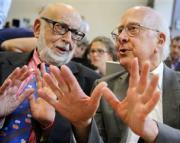Nobel Prize in physics confirms decades old theories
Listen to the full audio story
- Nobel Physics.mp3

This year's Nobel Prize in physics went to Francois Englert and Peter Higgs for their work on the discovery of Higgs Boson Particles. The particles, which are being called "God Particles" as they are the foundational building blocks of all elemental particles, have been Englert and Higgs' research focus for 50 years now.
As atoms and parts of atoms move around, Higgs particles slow them down for long enough to surround them and give them detectable mass. The discovery is being called the final cornerstone to the standard model of particle physics.
Englert and Higgs, now both in their 80s, worked with hundreds of other scientists and the Large Hadron Collider at CERN in Geneva to conduct experiments to prove the existence of Higgs particles, whose existence has been theorized for some time now.
In this piece, the Higgs-Boson particle and its signifcance is explained in simple terms by USC physics professor Dr. Clifford Johnson.
Check out the future home of Annenberg student media:

Wallis Annenberg Hall
(opening Fall 2014)

